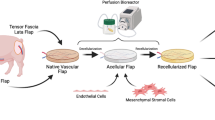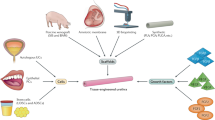Abstract
Purpose
We studied the late angiogenic activity of free grafts and a pedicle flap in a rabbit urethroplasty model to determine whether angiogenic activity plays a role in late outcomes of urethral reconstruction in rabbits.
Methods
Twenty-eight rabbits were randomly divided into five groups according to the method used to bridge a urethral defect as an onlay patch: Control, simple closure of urethral defect (Group O1); free penile skin graft (FPSG, Group A1); buccal mucosal graft (BuMG, Group B1); bladder mucosal graft (BlMG, Group C1); and pedicle penile skin flap (PPSF, Group D1). Angiogenic activity of the patch on postoperative day 84 was assessed by immunohistochemistry.
Results
The angiogenic activity in Groups O1, A1, B1, C1, and D1 was 23.33 ± 4.92 (means ± SD), 42.89 ± 6.52, 55.78 ± 3.46, 53.61 ± 6.17, and 24.11 ± 9.07 vessels per optical field, respectively. There were statistically significant differences (p < .001) between Group O1 and A1 B1, C1, Group A1 and B1, C1, D1, Groups B1 and D1 and Groups C1 and D1, but not between Groups O1 and D1 (p = 1.000) and Groups B1 and C1 (p = .872). The long-term angiogenic activity of all the groups was significantly lower (p < .001) than in the corresponding early groups.
Conclusions
Although the angiogenic activity of all the groups decreased in the late assessment, the buccal mucosal graft continued to exhibit elevated angiogenesis above bladder or skin (free or pedicle) graft. Therefore, buccal mucosal patch graft might be preferable because of its easier harvesting.


Similar content being viewed by others
References
Gardikis S, Giatromanolaki A, Ypsilantis P et al (2005) Comparison of angiogenic activities after urethral reconstruction using free grafts in rabbits. Eur Urol 47:417–421
Duckett JW, Coplen D, Ewalt D et al (1995) Buccal mucosal urethral replacement. J Urol 153:1660–1663
Dubey D, Vijjan V, Kapoor R et al (2007) Dorsal onlay buccal mucosa versus penile skin flap urethroplasty for anterior urethral strictures: results from a randomized prospective trial. J Urol 178:2466–2469
Atala A. (2008) Tissue engineering of the urethra. In: Brandes S.B (ed) Current clinical urology, urethral reconstructive surgery. Humana Press, Totowa, pp 337–345
Bhargava S, Patterson JM, Inman RD et al (2008) Tissue-engineered buccal mucosa urethroplasty—clinical outcomes. Eur Urol 53:1263–1269
Raya-Rivera A, Esquiliano DR, Yoo JJ et al (2011) Tissue-engineered autologous urethras for patients who need reconstruction: an observational study. Lancet 377:1175–1182
Carmeliet P (2003) Angiogenesis in health and disease. Nat Med 9:653–660
Simons M (2005) Angiogenesis: where do we stand now? Circulation 111:1556–1566
Folkman J, Shing Y (1992) Angiogenesis. J Biol Chem 267:10931–10934
Pu LL (2009) Discussion. Improvement of the survival of human autologous fat transplantation by using VEGF-transfected adipose-derived stem cells. Plast Reconstr Surg 124:1447–1449
Glotzbach JP, Levi B, Wong VW et al (2010) The basic science of vascular biology: implications for the practicing surgeon. Plast Reconstr Surg 126:1528–1538
Mitchell RN, Cotran RS (2003) Tissue repair: cell regeneration and fibrosis In: Kumar V, Cotran RS, Robbins SL (eds) Robbins basic pathology. Saunders, Philadelphia pp 61–78
Nishimura T, Hashimoto H, Nakanishi I et al (2000) Microvascular angiogenesis and apoptosis in the survival of free fat grafts. Laryngoscope 110:1333–1338
Liapakis IE, Anagnostoulis S, Karayiannakis AJ et al (2008) Recombinant leptin administration improves early angiogenesis in full-thickness skin flaps: an experimental study. In Vivo 22:247–252
Kambouri K, Gardikis S, Giatromanolaki A et al (2006) Comparison of angiogenic activity after urethral reconstruction using free grafts and pedicle flap: an experimental study. Eur J Pediatr Surg 16:323–328
Giatromanolaki A, Koukourakis M, O’Byrne K et al (1996) Prognostic value of angiogenesis in operable nonsmall cell lung cancer. J Pathol 179:80–88
Bhargava S, Chapple CR (2004) Buccal mucosal urethroplasty: is it the new gold standard? BJU Int 93:1191–1193
Mangera A, Patterson JM, Chapple CR (2011) A Systematic review of graft augmentation urethroplasty techniques for the treatment of anterior urethral strictures. Eur Urol 59:797–814
Akhavani MA, Sivakumar B, Paleolog EM et al (2008) Angiogenesis and plastic surgery. J Plastic Reconstr Aesthet Surg 61:1425–1437
Shweiki D, Itin A, Soffer D et al (1992) Vascular endothelial growth factor induced by hypoxia may mediate hypoxia-initiated angiogenesis. Nature 359:843–845
Lindenblatt N, Calcagni M, Contaldo C et al (2008) A new model for studying the revascularization of skin grafts in vivo: the role of angiogenesis. Plast Reconstr Surg 122:1669–1680
Filipas D, Fisch M, Fichtner J et al (1999) The histology and immunohistochemistry of free buccal mucosa and full-skin grafts after exposure to urine. BJU Int 84:108–111
Souza GF, Calado AA, Delcelo R et al (2008) Histopathological evaluation of urethroplasty with dorsal buccal mucosa: an experimental study in rabbits. Int Braz J Urol 34:345–351
Fichtner J, Filipas D, Fisch M et al (2004) Long-term outcome of ventral buccal mucosa onlay graft urethroplasty for urethral stricture repair: analysis of complications. Urology 64:648–650
Patterson JM, Chapple CR (2008) Surgical techniques in substitution urethroplasty using buccal mucosa for the treatment of anterior urethral strictures. Eur Urol 53:1162–1171
Andrich DE, Dunglison N, Greenwell TJ et al (2003) The long term results of urethroplasty. J Urol 170:90–92
Conflict of interest
There is no conflict of interest.
Author information
Authors and Affiliations
Corresponding author
Rights and permissions
About this article
Cite this article
Vaos, G., Gardikis, S., Giatromanolaki, A. et al. Long-term angiogenic activity of free grafts and pedicle flap in a rabbit urethroplasty model. World J Urol 31, 919–924 (2013). https://doi.org/10.1007/s00345-012-0875-4
Received:
Accepted:
Published:
Issue Date:
DOI: https://doi.org/10.1007/s00345-012-0875-4




